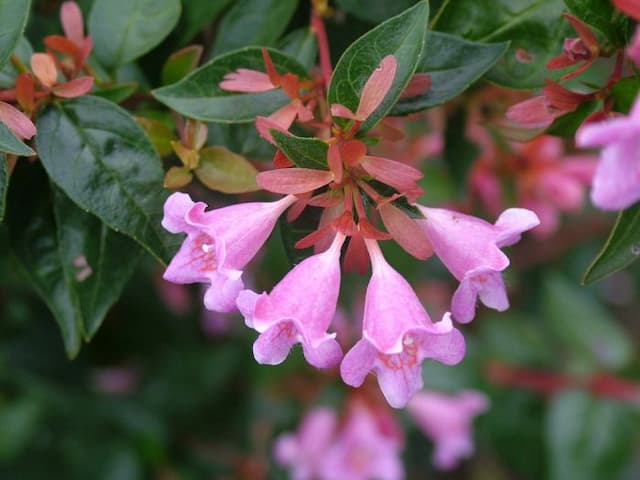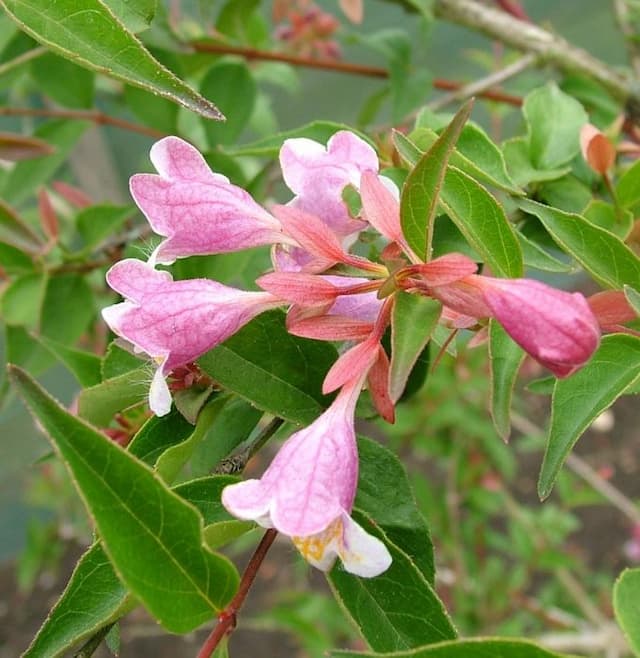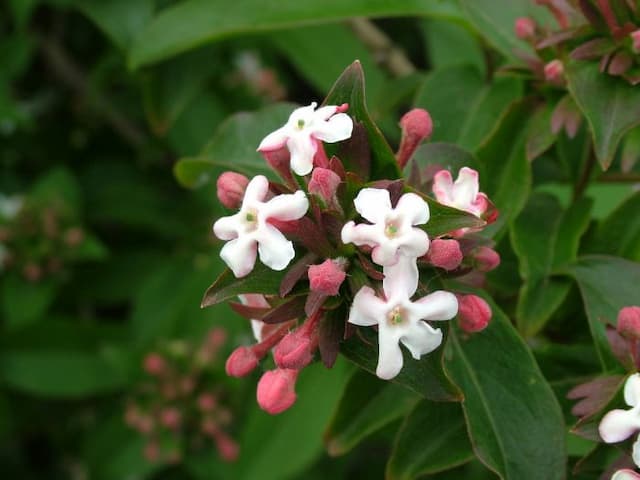Goldflame Honeysuckle Lonicera × heckrottii 'Gold Flame' hort.

ABOUT
The plant known commonly as Gold Flame honeysuckle is an ornamental vine celebrated for its beautiful and fragrant flowers. This plant showcases a striking fusion of colors in its bloom, with flower buds that emerge a rich, purply pink. As the flowers open, they reveal a dual color palette comprising of a soft, creamy yellow interior paired with a bold, pinkish-red exterior. The flowers are tubular, which is a characteristic trait of many honeysuckles, perfect for attracting pollinators such as hummingbirds and butterflies. These blooms are not only a visual delight but also emit a sweet, intoxicating fragrance that can perfume the air, particularly in the early morning and evening hours. Complementing the flowers are the plant's leaves, which are oval-shaped and have a blue-green hue that provides a lovely contrast to the vivid flowers. The leaves can also sometimes exhibit a slight bluish or purplish tint on the undersides, adding to the plant's overall allure. As a vine, it typically wraps and twines around any support it can find, often used on trellises, fences, or arbors to showcase its full ornamental potential. The plant has a robust and lively presence in the garden, providing color and fragrance throughout its blooming season.
About this plant
 Names
NamesFamily
Caprifoliaceae
Synonyms
Gold Flame Honeysuckle, Heckrott's Honeysuckle, American Woodbine
Common names
Lonicera × heckrottii 'Gold Flame' hort.
 Toxicity
ToxicityTo humans
The plant commonly known as Gold Flame Honeysuckle is not typically considered to be toxic to humans. However, it is always recommended to exercise caution and avoid ingesting plants that are not commonly recognized as edible, as individual allergic reactions or sensitivities can occur. If any part of the plant is ingested, watch for any adverse reactions and consult a medical professional if any concerning symptoms arise.
To pets
Gold Flame Honeysuckle is not generally known to be toxic to pets. However, as with humans, individual animals may have varying sensitivity to plants. If a pet were to ingest a significant amount of the plant, gastrointestinal upset may potentially occur as with any non-food item. If you notice symptoms of distress or unusual behavior after your pet has ingested this plant, it would be wise to contact a veterinarian.
 Characteristics
CharacteristicsLife cycle
Perennials
Foliage type
Deciduous
Color of leaves
Blue-green
Flower color
Mixed
Height
10-15 feet (3-4.5 meters)
Spread
5-6 feet (1.5-1.8 meters)
Plant type
Climber
Hardiness zones
5
Native area
Cultivar
Benefits
 General Benefits
General Benefits- Attracts Pollinators: Lonicera × heckrottii 'Gold Flame' is known for attracting bees, butterflies, and other beneficial insects which help in pollination.
- Aesthetic Appeal: The plant features beautiful gold and pink trumpet-shaped flowers that can enhance the visual appeal of any garden.
- Fragrance: It has a strong, sweet fragrance, making it a pleasant addition to landscapes where scent is an important feature.
- Wildlife Habitat: Provides nectar for hummingbirds and can serve as a food source for other wildlife.
- Versatility: Can be used in various landscape designs, including as a focal plant, in mixed beds, or as part of a border.
- Privacy Screen: When used as a hedge or fence cover, it can provide privacy due to its dense growth habit.
- Seasonal Interest: Offers extended interest with long flowering periods, typically from late spring to fall.
- Erosion Control: The root system can help stabilize slopes and prevent soil erosion.
- Garden Structures: Ideal for growing on trellises, arbors, or pergolas, adding vertical interest to gardens.
- Shade Tolerance: Capable of thriving in partially shaded environments, offering flexibility in garden placement.
- Easy to Grow: Relatively low maintenance and can be easily propagated from cuttings.
- Drought Tolerance: Once established, exhibits some tolerance to drought, reducing the need for frequent watering.
 Medical Properties
Medical PropertiesThis plant is not used for medical purposes.
 Air-purifying Qualities
Air-purifying QualitiesThis plant is not specifically known for air purifying qualities.
 Other Uses
Other Uses- Attracting Beneficial Insects: 'Gold Flame' honeysuckle can serve as a host plant for larvae of certain butterfly species, fostering a healthy and diverse garden ecosystem.
- Living Fences: This vigorous climbing plant can be trained on fences to create a natural, living barrier that provides privacy and aesthetic appeal.
- Shade Creation: By allowing 'Gold Flame' honeysuckle to grow over arbors or pergolas, you can create shaded areas in the garden, providing relief from the sun on hot days.
- Erosion Control: The plant's extensive root system can help stabilize slopes and areas prone to erosion, holding the soil in place.
- Seasonal Interest: The plant's vibrant flowers add a splash of color to gardens, and even when not in bloom, the foliage offers ornamental value throughout the growing season.
- Privacy Screens: When grown densely, 'Gold Flame' honeysuckle provides an effective visual screen, perfect for creating private outdoor spaces.
- Wildlife Shelter: The thick foliage can create a safe haven for small wildlife, offering them a place to hide and nest away from predators.
- Crafting Material: Flexible stems can be harvested and used for crafting projects like wreaths or plant supports with a rustic look.
- Garden Accent: 'Gold Flame' honeysuckle can be planted in containers and positioned as a focal point on patios or balconies.
- Photography Backdrop: The attractive flowers and foliage can serve as a picturesque backdrop for outdoor photography sessions.
Interesting Facts
 Feng Shui
Feng ShuiThe Honeysuckle is not used in Feng Shui practice.
 Zodiac Sign Compitability
Zodiac Sign CompitabilityThe Honeysuckle is not used in astrology practice.
 Plant Symbolism
Plant Symbolism- Love and Devotion: Lonicera, commonly known as Honeysuckle, is often associated with love and devotion due to its sweet fragrance and the way its vines cling to structures and other plants, which can be reminiscent of the clinging nature of love.
- Bonds of Friendship: The intertwining growth of the Honeysuckle vines symbolizes the close bonds of friendship, suggesting a strong interconnection and support between companions.
- Happiness: The bright color and pleasant smell of Honeysuckle are symbolic of happiness and cheerfulness, offering an uplifting presence in gardens and bouquets.
- Generosity: Honeysuckle's abundant nectar, which attracts hummingbirds and butterflies, can represent generosity, sharing, and the selfless provision of sustenance or wealth.
 Water
WaterThe Gold Flame Honeysuckle should be watered deeply so that the water reaches the roots, ensuring thorough soil hydration. In the growing season, water weekly with about 1 to 1.5 gallons for established plants, less for newly planted ones; adjust based on rainfall. During hot or dry spells, increasing to twice per week may be necessary. In winter, reduce watering frequency as the plant requires less moisture. Overwatering can be as detrimental as under-watering, so ensure the soil has good drainage and does not stay soggy.
 Light
LightGold Flame Honeysuckle thrives in full sun to partial shade. In most regions, the best results are obtained with a planting location that provides at least 6 hours of direct sunlight daily, such as in an east-facing or west-facing garden. Too much shade will result in fewer blooms and may lead to increased susceptibility to pests and diseases.
 Temperature
TemperatureGold Flame Honeysuckle prefers temperate conditions and can typically endure temperatures down to around 5°F and up to about 90°F. However, the ideal temperature range for this plant is between 60°F and 80°F. Sudden extreme temperature shifts can stress the plant, so it's important to consider proper placement to protect it from harsh winter winds or excessive summer heat.
 Pruning
PruningGold Flame Honeysuckle benefits from pruning to maintain shape, encourage bushier growth, and stimulate more blooms. Pruning should be done in late winter or early spring before new growth begins. Remove any dead or diseased branches and thin out as needed to allow light into the center of the plant. After flowering, trim back overly long shoots to keep the vine manageable.
 Cleaning
CleaningAs needed
 Soil
SoilGoldflame Honeysuckle thrives in a well-draining soil mix with a pH of 6.0 to 7.5. A blend of loamy garden soil, peat, and perlite or coarse sand is ideal to ensure adequate drainage and aeration. Adjust pH with lime to increase alkalinity or sulfur to increase acidity as required.
 Repotting
RepottingGoldflame Honeysuckle, being a vigorous climber, often doesn't require frequent repotting when planted in the ground. However, if grown in a container, repotting every 2-3 years into a larger pot can keep the plant healthy, preventing it from becoming root-bound.
 Humidity & Misting
Humidity & MistingThe Goldflame Honeysuckle flourishes at average outdoor humidity levels. It does not require any special humidity considerations as it's tolerant of a wide range of environmental moisture conditions.
 Suitable locations
Suitable locationsIndoor
Ensure bright light, support for climbing, and moderate watering.
Outdoor
Plant in sun-to-partial shade and provide trellis for support.
Hardiness zone
5-9 USDA
 Life cycle
Life cycleLonicera × heckrottii 'Gold Flame', commonly known as Gold Flame Honeysuckle, begins its life as a seed, requiring a period of dormancy before germination. Upon germination, the plant develops a root system and shoots which grow into a vine with leaves. As the vine matures, it produces fragrant tubular flowers from late spring to summer, which are pink to red outside with a golden-yellow interior. After pollination by insects, these flowers turn into small red to black berries, which contain seeds for the next generation of plants. As a perennial, Gold Flame Honeysuckle dies back in the fall with the onset of cold weather, only to resume growth from its rootstock with the return of warm spring temperatures. The plant continues this cycle, growing larger and more floriferous each year, for many years unless interrupted by disease, pests, or extreme environmental conditions.
 Propogation
PropogationPropogation time
Late winter to early spring
The optimal time for propagating the Goldflame Honeysuckle, Lonicera × heckrottii 'Gold Flame', is in late spring through early summer. The most popular method of propagation for this particular plant is semi-hardwood cuttings. To propagate by this method, a gardener would take semi-hardwood cuttings of about 4 to 6 inches in length (10 to 15 cm) from new growth that is just beginning to mature and become firmer. These cuttings should include several sets of leaves. The lower leaves should be removed and the cut end dipped in rooting hormone to encourage root growth. The cutting can then be planted in a well-draining soil mixture, ensuring that at least one set of leaves is above the soil surface. The soil should be kept consistently moist but not soggy, creating a humid environment by covering with a plastic bag or placing in a propagator can assist with root development. Roots typically begin to form within a few weeks to a couple of months. Once the cutting is well rooted, it can be transferred to a larger pot or directly into the garden.








![Himalayan honeysuckle [Golden Lanterns]](/_next/image?url=https%3A%2F%2Fplants-admin.emdemapps.com%2Fimages%2Fplants%2F%2Fimages%2F604b55302cc87.png&w=640&q=75)
